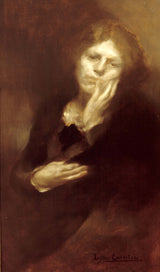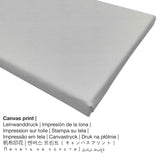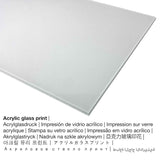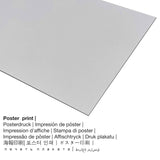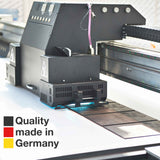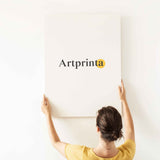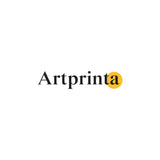Eugène Carrière, 1903 - Fantine gbahapụrụ - ọmarịcha akwụkwọ nka
Ụtụ gụnyere. Mbupu gbakọrọ na ndenye ọpụpụ.
Họrọ ụdị ebipụta nka nka
The product dropdown menu provides you with the opportunity to select your favorite size and material. Therefore, we allow you to choose among the following options:
- Mbipụta kanvas: The printed canvas, not to be confused with a canvas painting, is an image printed on an industrial printer. A canvas generates a exclusive effect of three dimensionality. The canvas makes a soft and appealing atmosphere. Hanging your canvas print: Canvas Prints have the advantage of being low in weight, which means that it is quite simple to hang your Canvas print without extra wall-mounts. Because of thata canvas print is suitable for all types of walls.
- Mbipụta akwụkwọ mmado (akwa akwa akwa): Our poster is a printed cotton canvas paper with a nice surface texture. Please note, that depending on the size of the poster we add a white margin of something between 2-6 cm around the work of art to facilitate the framing.
- Mbipụta ọla (aluminium dibbond): Aluminium Dibond prints are prints on metal with an impressive depth. The Direct Print on Aluminum Dibond is the ideal introduction to fine replicas on aluminum. For your Print On Aluminum Dibond, we print your selected work of art onto the aluminium white-primed surface. The colors are luminous and vivid in the highest definition, fine details are crisp.
- Glass acrylic e biri ebi (nwere ezigbo mkpuchi iko): The print on acrylic glass, often labelled as a an art print on plexiglass, will change the original into wall decoration. In addition to that, the acrylic art print is a viable alternative to canvas or dibond prints. The work of art will be custom-made thanks to state-of-the-art UV printing machines. With a glossy acrylic glass fine art print contrasts as well as smaller artwork details become identifiable with the help of the precise gradation. The acrylic glass protects your custom art replica against sunlight and heat for decades.
Ihe dị mkpa: We try our best to depict the products in as much detail as it is possible and to showcase them visually on the various product detail pages. Nonetheless, the pigments of the print products and the printing may differ to a certain extent from the image on the screen. Depending on the screen settings and the condition of the surface, not all colors can be printed 100% realistically. In view of the fact that all our fine art prints are processed and printed manually, there might also be minor deviations in the exact position and the size of the motif.
Additional information from the museum's website (© Copyright - by Maison de Victor Hugo - Hauteville House - www.maisonsvictorhugo.paris.fr)
Illustration novel by Victor Hugo, "Les Miserables" (1st part, Book III, IX)
It is through Arsène Alexandre Paul Meurice pass control of this painting Eugène Carrière. The letters that the critic of Le Figaro address Meurice to keep it informed of its efforts, provide information on the genesis of the work that the absence of dates on the letters makes unfortunately imprecise. Eugene Carriere is on the first list of proposed artists and we think of him for a subject from "The Art of being a grandfather." Noting the agreement of the painter, A. Alexander explains: "The idea of the Returning pleases career, but he seemed more eager to make a Jean Valjean, Cosette. What do you think ? From career would be quite new? ". Ultimately the choice will be fixed on Fantine - which is reported a first version carrying her baby in her arms (American al.) - here one that fits more in his favorite subjects - women and motherhood - "2nd Career No ' waiting more than an indication of its size to Fantine, and he feels so good it will do I am sure a very beautiful thing. "A final letter states:" Finally career writing to tell me the imminent dispatch of his Fantine is over and I hope some beautiful art joy. "
Fantine (literary character)
Ndị na-adịghị mma (V.Hugo)
Fantine abandoned is a work of art painted by Eugène Carrière in 1903. The original version measures the size of Height: 100 cm, Width: 60,2 cm, Thickness: 2 cm. Mmanụ, Canvas (ihe) was applied by the artist as the technique for the painting. The original artwork was inscribed with the information: Signature - Bottom right "Eugène Carrière". Besides, the artpiece is included in the digital art collection of Maison de Victor Hugo - Hauteville House in Paris, France. With courtesy of Maison de Victor Hugo - Ụlọ Hauteville (public domain license).The creditline of the artwork is the following: . On top of that, alignment of the digital reproduction is Eserese and has an aspect ratio of 9 : 16, meaning that the length is 45% shorter than the width. Eugène Carrière was a painter of French nationality, whose art style can primarily be classified as Realism. The European painter was born in the year 1849 na Gournay-sur-Marne wee nwụọ mgbe ọ dị afọ 57 na 1906 na Paris.
Nkọwapụta nka nka
| Aha eserese ahụ: | "Fantine abandoned" |
| nhazi ọkwa: | sere |
| Nhazi nka: | nkà nke oge a |
| Nhazi oge: | 20th narị afọ |
| Emepụtara na: | 1903 |
| Ogologo afọ nka nka: | karịa afọ 110 |
| Agba na: | Mmanụ, Canvas (ihe) |
| Nha izizi (ọrụ nka): | Ogologo: 100 cm, obosara: 60,2 cm, ọkpụrụkpụ: 2 cm |
| Ederede ihe osise izizi: | Signature - Bottom right "Eugène Carrière" |
| Ụlọ ihe ngosi nka / ebe: | Maison de Victor Hugo - Ụlọ Hauteville |
| Ebe ngosi nka: | Paris, France |
| Dị n'okpuru: | Maison de Victor Hugo - Ụlọ Hauteville |
| Ụdị nka nka: | ngalaba ọha |
| Site n'aka: | Maison de Victor Hugo - Ụlọ Hauteville |
Nkọwa akụkọ ahaziri ahazi
| Nkewa ngwaahịa: | ezi nka mmeputakwa |
| Usoro mmeputakwa: | dijitalụ mmeputakwa |
| Produzọ mmepụta: | mbipụta dijitalụ (Mbipụta UV ozugbo) |
| Mmalite nke ngwaahịa a: | emepụtara na Germany |
| Stockdị ngwaahịa: | mmepụta ihe na-achọ |
| Ojiji ngwaahịa: | mgbidi gallery, nka mgbidi |
| Ndepụta: | usoro eserese |
| Ụdị anya: | 9: 16 ogologo: obosara |
| Mmetụta akụkụ onyonyo: | ogologo bụ 45% mkpụmkpụ karịa obosara |
| Ụdị ihe dị iche iche dị: | Mbipụta iko acrylic (nke nwere ezigbo mkpuchi iko), mbipụta akwa akwa, mbipụta akwụkwọ mmado (akwụkwọ kwaaji), mbipụta ọla (aluminium dibbond) |
| Canvas dị n'elu ihe nrịbama (mbipụta kanvas) nha dị iche iche: | 50x90cm - 20x35", 100x180cm - 39x71" |
| Mpempe iko acrylic (nwere ezigbo mkpuchi iko) nha: | 50x90cm - 20x35", 100x180cm - 39x71" |
| Mpempe akwụkwọ mmado (akwụkwọ kwaaji) nha: | 50x90cm - 20x35" |
| Aluminium dibond ebipụta (ihe aluminium) dị iche iche: | 50x90cm - 20x35" |
| ụba: | mbipụta nka na-enweghị isi |
Ozi ndabere izugbe na onye na-ese ihe
| Ihe nkiri: | Eugène Carrière |
| okike nke onye nka: | nwoke |
| Nationality: | French |
| Ọrụ: | onye na-ese ihe |
| Obodo onye nka: | France |
| Nhazi nke onye nka: | omenkà nke oge a |
| styles: | Ihe ngosi |
| Ndụ: | 57 afọ |
| Afọ ọmụmụ: | 1849 |
| Amụrụ na (ebe): | Gournay-sur-Marne |
| Nwuru: | 1906 |
| Obodo ọnwụ: | Paris |
Ederede a bụ ikike ọgụgụ isi ma chekwaa ya site na nwebisiinka © - Artprinta (www.artprinta.com)

